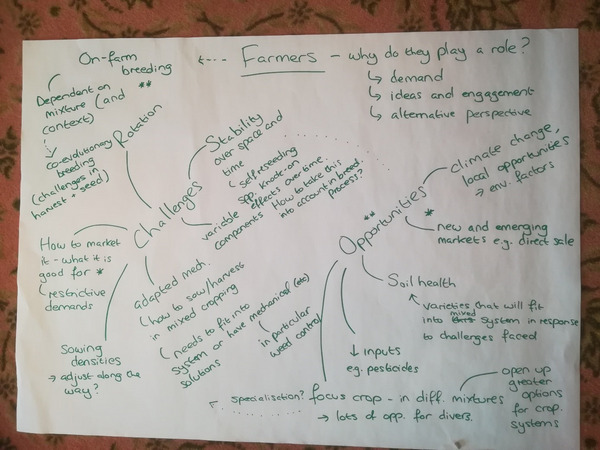Breeding for mixtures, however, is complex, and so the workshop set out to address this challenge by identifying existing knowledge and knowledge gaps in four topic areas:
- Relevant breeding targets
- Operational breeding methods
- Managing genotype-environment interactions
- Market opportunities and challenges
The workshop brought together crop scientists, breeders and organisations working closely with farmers (c. 25 people in total). After an introduction by Lars Kiær (University of Copenhagen) outlining the challenge, the discussions were kicked off with flash talks by Grietje Raaphorst-Travaille (Nordic Maize Breeding, NL) who outlined the various crop combinations that she is working with for maize selection, and Benedikt Haug (FiBL, Switzerland) who introduced Peter Kunz’s work on pea breeding for pea-barley mixtures. Benedikt is now conducting his PhD as part of the ReMIX project on the 'Development of genetic models to breed for mixed cropping systems' and also presented his work in a session on breeding for interspecific mixtures at the conference.
In the workshop, the participants were divided into four discussion groups, each tasked with representing the views of a specific stakeholder group (breeder, crop scientist, farmer, and processor) and asked to identify the major advances in mixture breeding and the key knowledge gaps from the perspective of ‘their’ stakeholder group. The discussions were facilitated by colleagues in the crop diversification cluster: Jerome Enjalbert (INRA/ReMIX), Emma Forst (INRA, France/ReMIX), Benedikt Haug (FiBL, Switzerland/ReMIX), Wijnand Sukkel (WUR, NL/DiverIMPACTS), Charlotte Bickler (ORC, UK/DIVERSify) and Frédéric Muel (Terres Inovia, France/LegValue).
Feedback from the discussion groups highlighted similarities and differences between the stakeholder perspectives in terms of the traits considered of greatest importance. See figure 1 for a summary of the discussion from the farmer's perspective: do you agree with the points being drawn?
It is clear that breeding for mixtures adds complexities to the breeding process but breeding in mixtures also provides opportunities. The opportunities for novel breeding methods, such as population breeding, and participatory breeding approaches were highlighted in different groups. It was an intensive session packed with ideas and inspiration for future breeding work. We will be consolidating the different group’s perspectives and developing soon a more detailed output identifying the opportunities and challenges presented by breeding for crop mixtures.
More information
Contacts
- Dr Lars Kiær, University of Copenhagen, Denmark, Leader of DIVERSify work package 2, lpk@plen.ku.dk
- Dr. Alison Karley, James Hutton Institute, Coordinator of Diversify, Crop Diversification Cluster Working Group on Communication, Alison.Karley(at)hutton.ac.uk
- Dr. Charlotte Bickler, Organic Research Centre Elm Farm, UK, Dissemination officer of Diversify, Crop Diversification Cluster Working Group on Communication, charlotte.b(at)organicresearchcentre.com;
Weblinks
- CropDiversification.eu: Website of the crop diversification cluster
- ZENODO.org: First European Conference on Crop Diversification: Book of Abstracts. For workshop info see page 359 at https://www.zenodo.org/record/3516329

 tap and then scroll down to the Add to Home Screen command.
tap and then scroll down to the Add to Home Screen command.